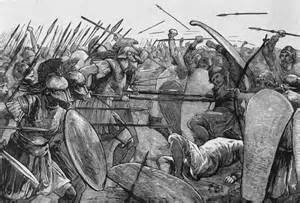The Peloponnesian War
Part 2: Siege and Intrigue It is important to remember that things sometimes moved much more slowly in ancient times. In the absence of airplanes and tanks and other means of transporting troops and equipment rapidly over large distances, opposing forces were sometimes very slow in confronting each other, especially if the distance between homelands was large. Such was the case to a certain extent with the Peloponnesian War.
The city of Athens, however, was ravaged at that time (430 B.C.) by a deadly plague, which killed a large part of the population, including the leader, Pericles. (Some sources say that as many as two-thirds of the Athenian population died.) Weakened in population, Athens fought on in the water, as Athenian ships scored major victories over Peloponnesian possessions, including major victories as in the Battle of Sphacteria (425). Not to be outdone, Sparta summoned more soldiers and turned the battle elsewhere, to the Athenian colony of Amphipolis, in Thrace. This colony was strategic for its position, controlling access to much of the northern Aegean territories, and for its wealth, in the form of gold mines. Spartan forces under the general Brasidas took Amphipolis. It is at this point that the famous historian Thucydides enters the series of events. He was supposed to counter the Spartan invasion of Amphipolis, but he and his forces arrived too late to affect the outcome and he was exiled from Athens. Meanwhile, Athens sent another force, led by Cleon, the victor of Sphacteria, to try to retake Amphipolis. Sparta repulsed this attack, which killed both Cleon and Brasidas. Athens sued for peace, and Sparta accepted, in 421. The terms hammered out in negotiations between Spartan king Pleistoanax and Athenian general Nicias ended the fighting. What followed was six years of what came to be known as the Peace of Nicias. Next page > All Fall Down > Page 1, 2, 3 |
|
Social Studies for Kids
copyright 2002–2024
David White



 The first phase, known as the Archidamian War, began in 431, nearly a decade after the rebellion of Samos. This phase was named after Spartan king Archidamus II, who launched another invasion of Attica, after an initial flare-up between Plataea, an Athenian ally, and Thebes, a Spartan ally. Unlike the one that forced Athens into reatreating, this one had a different outcome. The Athenian strategy of building high, thick walls around the city and its nearby port, Piraeus, meant that the Athenian forces and population could huddle within the walls without fear of being overrun by a superior Spartan army. Siege warfare at this time consisted almost entirely of an invasion force's occupying the territory surrounding a city or settlement and resorting to starvation methods in order to force subjugation. Athens, with its high walls and access to a port and a large navy to protect it (and facing little Spartan firepower in the form of ships), could afford to play a waiting game, also because the siege wasn't permanent: Soldiers at the time were expected to go back to their homes at harvest time to help supervise the work of the Spartan slaves, called helots. So although Sparta was technically besieging Athens, the siege was actually a series of sieges, the longest of which was 40 days.
The first phase, known as the Archidamian War, began in 431, nearly a decade after the rebellion of Samos. This phase was named after Spartan king Archidamus II, who launched another invasion of Attica, after an initial flare-up between Plataea, an Athenian ally, and Thebes, a Spartan ally. Unlike the one that forced Athens into reatreating, this one had a different outcome. The Athenian strategy of building high, thick walls around the city and its nearby port, Piraeus, meant that the Athenian forces and population could huddle within the walls without fear of being overrun by a superior Spartan army. Siege warfare at this time consisted almost entirely of an invasion force's occupying the territory surrounding a city or settlement and resorting to starvation methods in order to force subjugation. Athens, with its high walls and access to a port and a large navy to protect it (and facing little Spartan firepower in the form of ships), could afford to play a waiting game, also because the siege wasn't permanent: Soldiers at the time were expected to go back to their homes at harvest time to help supervise the work of the Spartan slaves, called helots. So although Sparta was technically besieging Athens, the siege was actually a series of sieges, the longest of which was 40 days.
